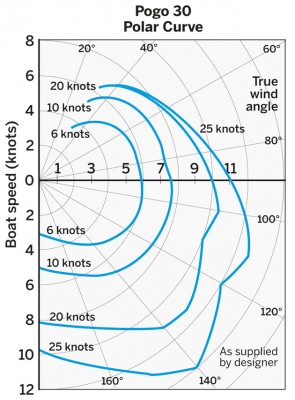Is the Pogo 30 the most fun you can have in a cruising 30-footer? Very probably, says Toby Hodges after an exhilarating romp off Brittany, so long as creature comforts are not uppermost in your priorities
Pogo 30 on test – pocket performer with cruising aspirations
Build & yard
Pogo Structures started out building half-tonners in the late Eighties. Christian Bouroullec, a former class winner of the Mini Transat in 1999, is the original builder and still owns the yard, which can produce around 50 Pogos a year. Around 70 per cent of the Mini Transat fleet is comprised of series production boats, with 90 per cent of these by Pogo. This engenders confidence in the yard’s ability to build multiple boats to a high standard.
Cruising clients get a choice of polyester or vinylester hull and decks. Apparently, the weight difference is negligible, but using vinylester resin produces a stiffer, more water-resistant structure. Everything Pogo builds is moulded and resin-infused, allowing it to keep strict control over its boats’ weight and quality as well to optimise every part used.
Unsinkable foam is used for buoyancy in most places other than stowage, including within the longitudinal stiffeners. Hull, deck and bulkheads have a PVC foam core of varying density. A Class 40 in build uses the same techniques and materials as the 30, but with frame stiffeners every metre.
Specifications
LOA 9.14m/29ft 12in
LWL 8.94m/29ft 4in
Beam (max) 3.70m/12ft 2in
Draught 1.90m/6ft 3in
Disp (lightship) 2,800kg/6,173lb
Sail Area 51.9m2/559ft2
Berths 6
Engine 13hp Volvo saildrive
Water 135lt/30gal
Fuel 40lt/9gal
Sail area: Disp: 26.6
Disp:LWL 109
Price (ex VAT) €82,935 (£70,352)
Design: Finot Conq
Conclusion
It’s different. It’s cool. It’s stiff. It’s light. It even whistles. And yes, it is more of an ‘it’ than a she. The Pogo 30 is muscular yet lightfooted and behaves similarly to a fast dinghy or multihull: direct, fast and fun with a potential to pulsate in any given puff.
Monohulls that plane tend to be lightweight dinghies or raceboats. So, when you get up to speed you get a big hit of adrenaline as the boat is pushed to the limits of control.
Cruising on the Pogo was different. Planing only heightened the feeling of relaxed sailing, while also reducing the loads and passage times. Travelling above the water (rather than pushing through it) is addictive. Of course there are negatives too: the open, free-standing heads is impractical at sea; there’s no feedback from the helms; you have to be careful of the rudders swinging over when motoring astern.
Yet the base price of the 30 is competitive given its strong, light build and what you lose in furnishings you gain in performance. If all its wetted area suggests that she could be sticky, I can only say it didn’t seem it to me.
If you don’t stay aboard for long periods or aren’t too fussed about creature comforts, this could be your boat. If you’re after simple sailing pleasure at an appealing price, this is definitely your boat.
This is test appeared in Yachting World December 2013 issue






